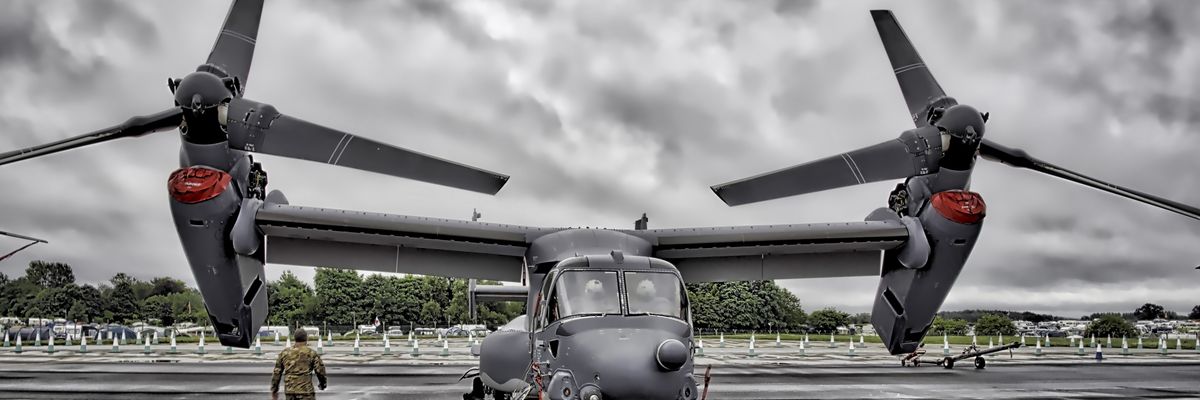The V-22 Osprey flies like a bird and hovers like a bee.
Furnished with rotors at the end of each wing, the aircraft takes off and lands like a helicopter but relies on its fixed wings to go the distance during flight. For this reason, some consider the Osprey the best of both worlds in aviation — others call it “the widow maker.”
Just a few weeks ago, three Marines died in an Osprey crash during a training exercise in Australia, bringing total fatalities involving the Osprey to over 50. And while there are certainly more dangerous aircraft out there (take the CH-53E helicopter, for example), what’s striking about the Osprey is that since the aircraft became operational in 2007, most of the fatalities involving the aircraft have happened during training exercises, not active operations.
Still, the Osprey isn’t historically reliable when it comes to combat readiness. In fact, the program missed the boat on meeting its reliability rate goals in every year from 2011 to 2021 — despite taking its first flight in 1989. The aircraft didn’t make its combat debut until 2007, having missed deployment to “Bosnia in 1995, Afghanistan in 2001, and Iraq in 2003.” And for good reason — during the testing phase, the aircraft experienced four crashes resulting in 30 fatalities.
Since then, the program has grappled with persistent design flaws, significantly increasing the program’s costs. From 1986 to 2007 alone, the program’s research, development, testing, and evaluation costs ballooned by over 200 percent.
With rotors situated atop wings like tree branches, the Osprey requires serious horsepower to get moving. There are two engines to propel the rotors, lifting the aircraft for vertical takeoff and then thrusting the Osprey forward during flight. So as you can imagine with not one, but two rotors, the Osprey generates excessive wind on the ground.
Its rotor downwash proved problematic in Iraq, during the Osprey’s first deployment in 2007. In a desert environment, the pilots couldn’t see anything! The Marine Corps ended up tasking CH-53E pilots with scouting out landing zones for the Ospreys — largely defeating the purpose of a helicopter/airplane hybrid.
The issue of the Osprey’s rotor blast persists. Not only does it impair pilot visibility, but it literally kicks soil into the aircraft’s engines. In 2019, the Department of Defense Inspector General (IG) reported that the Osprey remains at risk of engine failure. Over nine years of attempts to redesign the Navy version of the aircraft and to prevent engine ingestion of natural materials have failed. The IG went so far as to state that redesign may not even “correct long-standing problems with the V-22.”
Besides the risks associated with the Osprey’s rotor blast, the aircraft struggles with a troublesome gearbox. The faulty device can cause the engine clutch to slip, which unintentionally disengages one of the aircraft’s proprotors — dually functioning as a rotor and propellor. A malfunctioning proprotor (even if only disengaged for a matter of moments) sends a lurch through the aircraft, throwing it off balance and causing it to nosedive.
That’s what happened last summer when five Marines died in an Osprey crash in California. An investigation into the crash recently revealed that there was nothing pilots could have done to prevent or respond to the issue. And while investigations into other recent Osprey crashes have not yet been released, it appears the gearbox issue played a role in several recent Osprey “mishaps.” The Air Force grounded its V-22 fleet last summer because of the issue, and the Marine Corps and Navy have since followed suit, grounding an undisclosed number of Ospreys.
The military has known about the gearbox and clutch problem since 2010, when an Air Force Osprey crash killed four people and injured many others. But as my colleague Mark Thompson has pointed out, this particular mechanical challenge greatly resembles those of older helicopters — the 67 UH-1 Huey and AH-1 Cobra in particular — which faced rotor issues that “killed hundreds of troops between 1967 and 1983.”
In the case of those aircraft, the rotors didn’t just disengage, but in some cases separated from the aircraft entirely. With that terrifying imagery in mind, imagine watching the military blame a crash on pilots no longer around to defend themselves.
Another through line between the Osprey, the Huey, the Cobra, and even the CH-53E is the tendency for the services to attribute mishaps to pilot error. Thompson notes that, in the 1980s, the Army produced a film to train and educate aviators on how to avoid the Cobra and Huey’s rotor issues before eventually grounding the Huey and replacing parts in both aircraft to fix the issue. The tradition continues with the Marine Corps repeatedly blaming pilots for CH-53E and Osprey crashes, the latter of which prompted the late Walter Jones — who represented North Carolina’s 3rd congressional district — to lead a 14-year-long crusade to clear the names of two pilots who died in a 2000 crash.
Jones was ultimately successful in spite of the squadron commanders’ mischaracterization of the V-22’s true performance through incomplete and/or inaccurate readiness reports.
Time will tell the true causes of the most recent Osprey crashes, but if history is any indication, there will be several contributing factors. The question now is how investigators will weigh them.
Regardless, the effectiveness of the Osprey is more critical to investigate now than ever as the Army prepares to launch the V-280 Valor program, which is set to eventually replace the Army’s fleet of Black Hawk helicopters.
This new program, which could cost up to $70 billion in its lifetime, will supposedly help the Army prepare for a potential future war in the Pacific. There, issues of range could be a serious factor, so the V-280 Valor will employ a similar design as the V-22. But that means it will likely face the same sort of challenges and tradeoffs as the Osprey, like unreliability and expensive maintenance needs.
- Osprey grounding highlights dangers of space-age aircraft ›
- 11 Marines have died in Osprey training crashes since last year ›
- Osprey crash in Japan kills at least 1 US soldier - Responsible Statecraft ›
- Military officials: 'widowmaker' Osprey will fly with a faulty clutch | Responsible Statecraft ›
- The US military chases shiny new things and the ranks suffer | Responsible Statecraft ›
- Army prematurely pushes aircraft into production | Responsible Statecraft ›
















